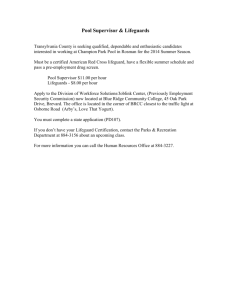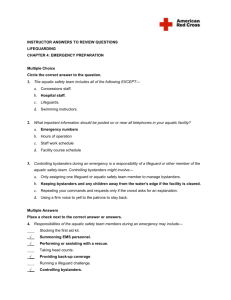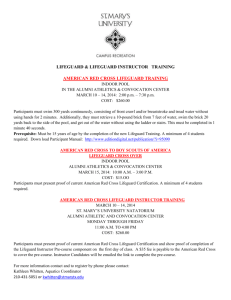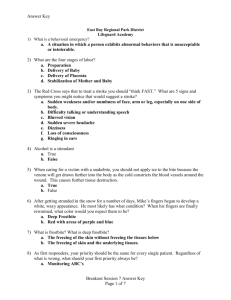Lifeguarding: The Professional Lifeguard - Instructor Answers
advertisement
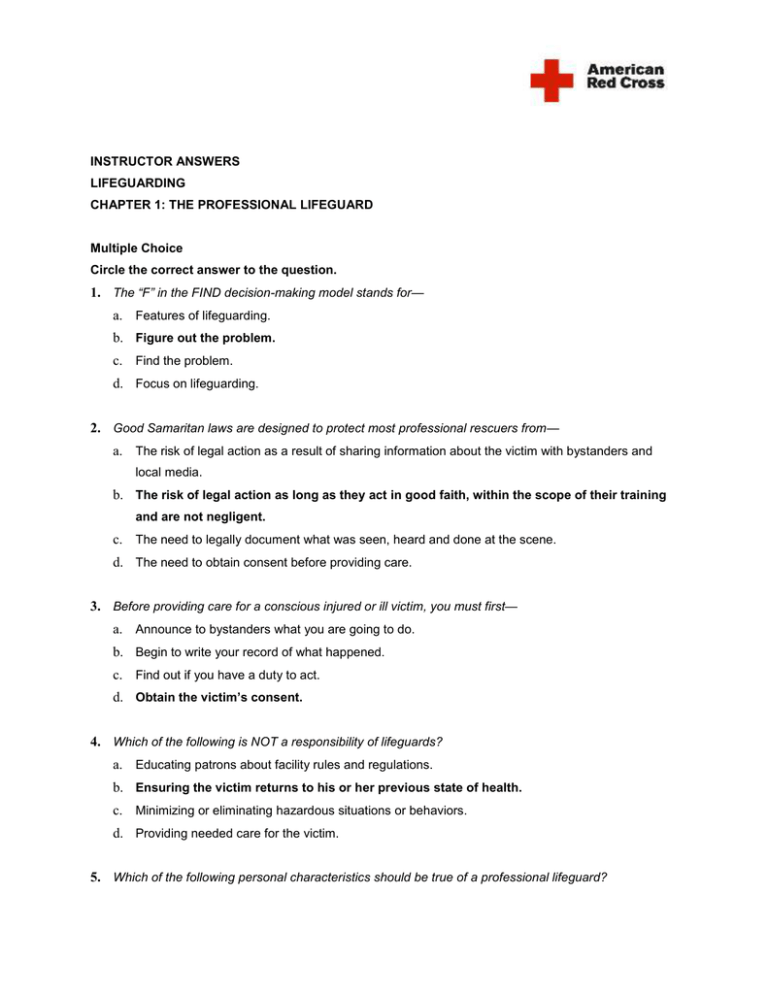
INSTRUCTOR ANSWERS LIFEGUARDING CHAPTER 1: THE PROFESSIONAL LIFEGUARD Multiple Choice Circle the correct answer to the question. 1. The “F” in the FIND decision-making model stands for— a. Features of lifeguarding. b. Figure out the problem. c. Find the problem. d. Focus on lifeguarding. 2. Good Samaritan laws are designed to protect most professional rescuers from— a. The risk of legal action as a result of sharing information about the victim with bystanders and local media. b. The risk of legal action as long as they act in good faith, within the scope of their training and are not negligent. c. The need to legally document what was seen, heard and done at the scene. d. The need to obtain consent before providing care. 3. Before providing care for a conscious injured or ill victim, you must first— a. Announce to bystanders what you are going to do. b. Begin to write your record of what happened. c. Find out if you have a duty to act. d. Obtain the victim’s consent. 4. Which of the following is NOT a responsibility of lifeguards? a. Educating patrons about facility rules and regulations. b. Ensuring the victim returns to his or her previous state of health. c. Minimizing or eliminating hazardous situations or behaviors. d. Providing needed care for the victim. 5. Which of the following personal characteristics should be true of a professional lifeguard? a. Eat and hydrate properly only on days when you are working. b. Maintain a professional attitude, appearance and healthy lifestyle. c. Update certifications within a year after they expire. d. Use sun protection and sunglasses only on hot, sunny days. 6. If a victim of injury or illness refuses care, you should— a. Continue to provide care as needed. b. Explain to the victim why he or she needs care and request the victim to at least allow someone more highly trained, such as EMS personnel, to evaluate the situation. c. Interview bystanders and fill out the incident report. d. Tell the victim you are trained to help, your level of training and what you think may be wrong. 7. Negligence includes all of the following EXCEPT— a. Failing to control or stop any behaviors that could result in further harm or injury. b. Failing to provide care. c. Providing inappropriate care. d. Providing the standard of care. Matching 8. Match each term with the correct definition. A. Abandonment B. Confidentiality C. Duty to Act D. Negligence E. Standard of Care C Legal responsibility to act in an emergency while on the job. B The victim’s right to privacy, which is protected by not sharing information learned about the victim. E Guidelines and expectations for professional rescuers, which may be established in part by their training program and in part by state or local authorities. D A failure to follow the standard of care or failure to act, which results in someone being injured or causes further harm to the victim. A Leaving the scene of an emergency or ceasing to provide care for a victim who requires ongoing care before someone with equal or greater training arrives and takes over. Multiple Answers Place a check next to the correct answer or answers. 9. To look professional and be prepared to respond appropriately to any situation, a professional lifeguard must— Wear the lifeguard uniform when on and off duty. _√ Be well groomed. Keep rescue equipment locked in the storage room so it is ready for use when on duty. _√ Sit or stand upright at the lifeguarding station. _√ Keep eyes focused on the assigned area of responsibility at all times. Keep essential personal gear, such as sunglasses, away from the lifeguard station while on surveillance duty. _√ Observe all facility rules, regulations and policies. Eat only when in the lifeguard office or on the lifeguard stand when the area of responsibility is clear of patrons. 10. Which of the following situations would require obtaining consent from the individual or from a parent or guardian before providing care? An unconscious victim of a head injury. _√ A person who is conscious with a minor open wound. _√ A person who is currently conscious but previously was unconscious, according to his friend. _√ A child who is with his parents but is unconscious from an accident. _√ A person who can talk and can give information regarding his or her injury or illness. An unconscious child at a lakefront who carpooled with another family but whose parents or guardian cannot be located. A college student who is confused and was seriously injured during a nonfatal submersion. True or False Circle true or false. 11. True False The vast majority of states and the District of Columbia have Good Samaritan laws. 12. True False Good Samaritan laws protect people who willingly provide emergency care without accepting anything in return. 13. True False Good Samaritan laws protect people from legal liability resulting from a victim’s injury if they act in good faith and provide care outside of their level of training. 14. True False Good Samaritan laws may not protect a rescuer from legal liability resulting from a victim’s injury if the rescuer stopped providing care and left the scene of the emergency before another rescuer of equal or more advanced training arrived to take over. 15. True False Good Samaritan laws protect all lifeguards. 16. True False Since accuracy is important in completing your agency’s accident reports, remember to record facts, names and personal opinions and feelings when completing the forms. 17. True False To learn what the lifeguard team members should expect from one another, team members must communicate and practice the facility’s EAP together. 18. True False Annual certification training may include CPR and AED review courses, lifeguarding review courses and review of lifeguarding knowledge and skills. 19. True False Only lifeguards at seasonal facility need to have annual certification training. 20. True False Seasonal lifeguards can lose knowledge and skills during the off-season. Fill in the Blanks 21. The primary responsibility of a lifeguard is to ensure patron safety and protect lives. This can be done in several ways, such as— a. Preventing injuries by minimizing or eliminating hazardous situations or behaviors. b. Enforcing facility rules and regulations and educating patrons about them. c. Recognizing and responding quickly and effectively to all emergencies. d. Administering first aid and CPR or using an AED in an emergency and, if trained, administering emergency oxygen when needed. e. Informing other lifeguards, facility staff and management when more help or equipment is needed. 22. The lifeguard team will work together better when they understand the expectations of management as well as what they can expect from each other. 23. When using the FIND decision-making model applied to lifeguarding decisions, FIND means— a. Figure out the problem. b. Identify possible solutions. c. Name the pros and cons for each solution. d. Decide which solution is best. Circle the Correct Answer from the Pair 24. Preventive lifeguarding (is/is not) one of the keys to minimizing emergency situations. 25. You, the first rescuer, arrive on the scene of an injured minor whose parents are present. The 15 year old gives consent for you to treat him or her. You (do/do not) need consent from a parent or guardian of the teenager. 26. Earning a lifeguarding certification (means/does not mean) someone has learned all there is to know about lifeguarding. Short Answer 27. List at least five characteristics of a professional lifeguard. Answers should include any five of the following: o o o o o o o Knowledgeable and have appropriate skills Reliable Mature Courteous and consistent Positive Professional Healthy and fit 28. List at least three reasons that a professional lifeguard must exercise as part of his or her responsibility to the job. Answers should include any three of the following: o o o o Stay healthy Be ready to perform strenuous rescues Stay alert Cope with stress and fatigue 29. List at least five legal principles involved in emergency care. Answers should include any five of the following: o o o o o o o o o Duty to act Standard of care Negligence Good Samaritan laws Consent Refusal of care Abandonment Confidentiality Documentation 30. Provide two important reasons for documenting an injury or incident. o A record can provide legal documentation of what you saw, heard and did at the scene. o As time passes, critical details may be forgotten. A record provides factual information on the injury or incident. 31. How can management ensure a good lifeguard team for their facility? Answers should include any of the following: o Be sure that team members are trained and evaluated together. o Be sure that team members practice working together as a unit. o Everyone who works at the facility needs to know his or her role in an emergency and how and when to call for more help. o All staff must practice the facility’s EAP together until everyone knows his or her responsibilities and can perform them correctly. o Be sure that team members understand the expectations of management as well as what they can expect from each other. 32. Name three things management can do to support the professional lifeguard. o Provide a policies and procedure manual. o Provide training, including annual or preseason orientation and training and regular and frequent in-service training. o Provide opportunities for recognition and career development.
